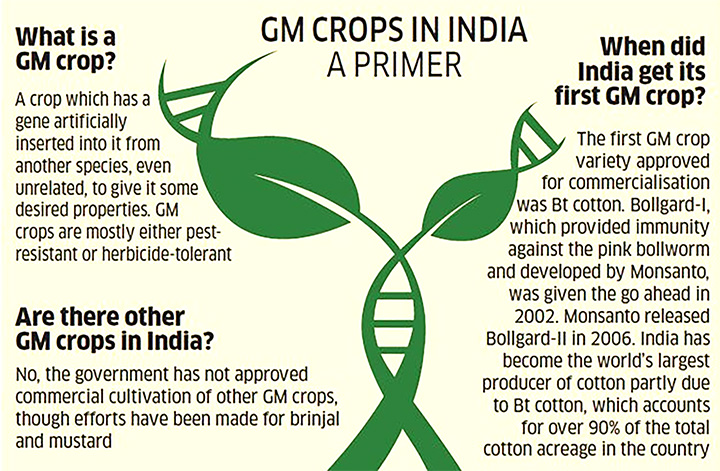Genetically Modified (GM) Crops
Why in News
According to the Coalition for GM Free India, the discovery of 500 tonnes of Genetically Modified (GM) rice in a consignment that India exported to the European Union countries in June 2021 has led to the “loss of reputation of India and its agricultural market’’.
- However, India pointed out that GM rice is not grown commercially in India, let alone exported, and promised a thorough enquiry by its agricultural exports authority, the Agricultural and Processed Food Products Export Development Authority (APEDA).
Key Points
- GM Crops:
- GM foods are derived from plants whose genes are artificially modified, usually by inserting genetic material from another organism, in order to give it a new property, such as increased yield, tolerance to a herbicide, resistance to disease or drought, or to improve its nutritional value.
- Probably the best known variety of GM rice is golden rice.
- Golden rice involves the insertion of genes from a plant -- both daffodils and maize have been used -- and a soil bacterium to create a grain that is enriched with Vitamin A.
- India has approved commercial cultivation of only one GM crop, Bt cotton.
- No GM food crop has ever been approved for commercial cultivation in the country.
- However, confined field trials have been allowed for at least 20 GM crops.
- That includes varieties of GM rice which would have improved resistance to insects and diseases, as well as hybrid seed production and nutritional enhancements such as golden rice.
- The cons of GM foods are that they may cause allergic reactions because of their altered DNA and they may increase antibiotic resistance.
- Export of GM Rice (Implications for India):
- India is the world’s top rice exporter, earning Rs. 65,000 crore in 2020 by selling 18 million tonnes of grain (organic rice), about a quarter of which is premium basmati.
- Among the 75 countries which buy Indian rice, West Asian nations, the US and the U.K. are the biggest importers of basmati, while the majority of non-basmati goes to African countries and neighbours Nepal and Bangladesh.
- For Indian farmers, the nightmare scenario could be what happened in the US in 2006, when trace amounts of a GM rice variety were found in shipments ready for exports.
- Trading partners such as Japan, Russia and the EU suspended rice imports from the US, hitting farmers hard.
- Under pressure from the rice export lobby at the time, India drafted policies to ban GM rice trials in the basmati belt. However, farmers from other parts of the country, especially those aiming for the nascent but growing organic rice export market, worry that their products could face contamination.
- Unauthorised HtBt Cotton and Bt Brinjal are already being grown commercially, with hundreds of growers blatantly defying the governmental ban.
Way Forward
- India’s top rice scientists seem to have moved away from conventional GM rice research for the time being.
- Recently, first varieties of non-GM herbicide tolerant rice were launched which can also be directly seeded, thus saving on water and labour costs (Pusa Basmati 1979 and Pusa Basmati 1985).
- The IARI (Indian Agricultural Research Institute) is also working to create drought-tolerant, salinity-tolerant rice strains through new gene editing technology (Site Directed Nuclease (SDN) 1 and 2) - which is yet to gain regulatory approval -- which allows for tweaking the rice plant’s own genes without introducing the genes of any other organism.
- In the face of such new advances, the regulatory regime needs to be strengthened, for the sake of domestic as well as export consumers.
- Technology approvals must be streamlined and science-based decisions implemented.
- Rigorous monitoring is needed to ensure that safety protocols are followed strictly, and enforcement must be taken seriously to prevent the spread of illegal GM crops.
